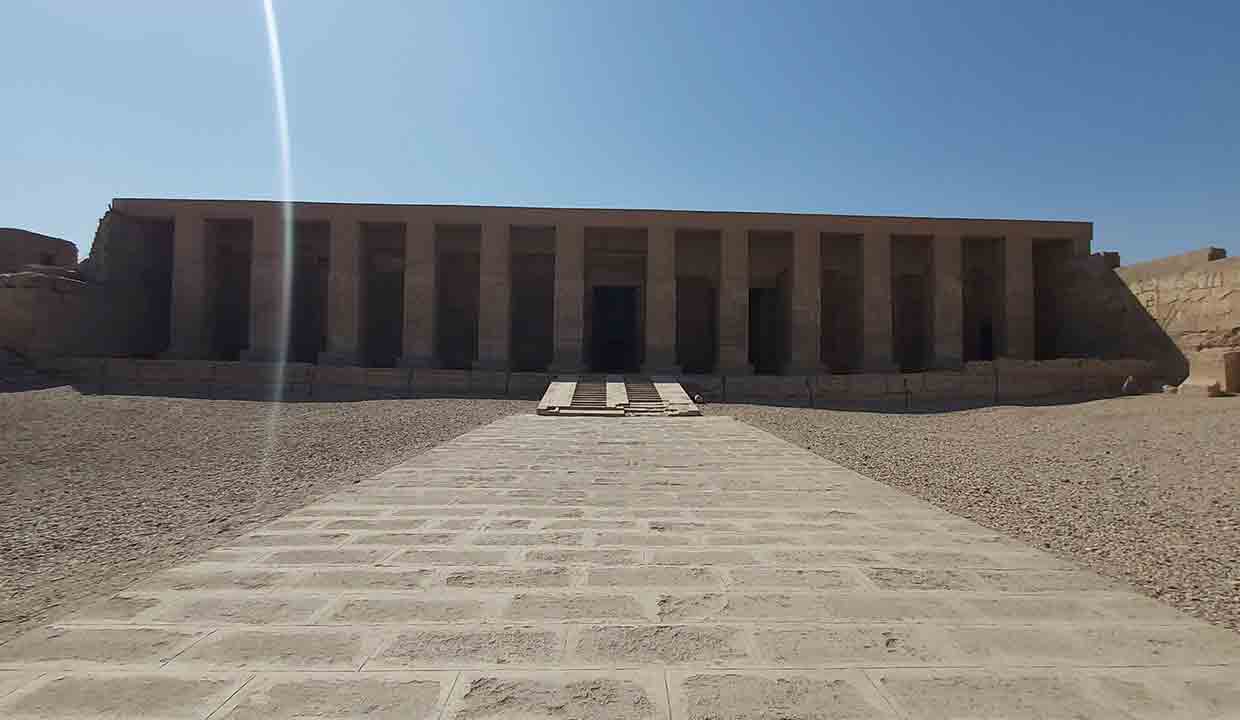Uncover Abydos’ treasures! The timeless Temple of Abydos beckons with stories of gods and pharaohs, set amidst stunning architectural feats.
The ancient Egyptian city of Abydos is renowned for its magnificent temples, including the Great Temple of Abydos built by Pharaoh Seti I. This often-overlooked historical site carries within its walls centuries of history, fascinating tales of ancient Egypt, and awe-inspiring architectural finesse.
Diving into Abydos: A Brief Overview
Abydos, nestled on the Nile’s west bank, has been a pivotal archaeological and religious site since antiquity. It hosts numerous temples, each narrating different aspects of Egyptian history and mythology. The city is famously associated with the cult of Osiris, the god of afterlife, embodying death and resurrection’s cyclic nature.
Great Temple of Abydos: Seti I’s Grand Contribution
The Great Temple of Abydos, primarily attributed to Pharaoh Seti I, stands out amongst the myriad of ancient structures scattered across the area. Also known as the Temple of Seti I, it was erected during the 19th Dynasty in the New Kingdom period, approximately in the 13th century BCE. Seti I initiated its construction but his son, the famed Ramses II, completed it.
This temple is unique due to its L-shaped structure, which comprises two distinct parts: the Osireion at the back and the temple proper at the front. This layout is indicative of the site’s dual function as both a cultic sanctuary and a funerary monument.
Understanding the Seti I Temple Architecture
A deep observation of the Seti I Temple’s architecture reveals Egypt’s ancient architectural intellect and artistic vision. The front part of the temple is meticulously organized with seven sanctuaries dedicated to different deities including Ptah, Re-Horakhty, Amun-Re, Osiris, Isis, and Horus. Each sanctuary is an embodiment of religious significance, adorned with fine reliefs and inscriptions delineating respective gods’ tales and exploits.
On the other hand, the Osireion, located at the rear, is an enigmatic structure resembling early dynastic funerary architecture. Its red granite pillars and massive stone blocks evoke the aesthetics of ancient sacred sites, serving as a symbolic tomb for Osiris.
Exploring the Abydos King List
One of the Great Temple’s standout features is the Abydos King List – a chronological list of 76 kings, meticulously inscribed on the temple walls. This record, while not exhaustive, provides invaluable insight into Egypt’s royal lineage, excluding certain names while accentuating others, reflecting the period’s political dynamics.
This King List, carved in meticulous hieroglyphs, begins with the mythical Menes and concludes with Seti I himself. Its presence underscores the temple’s role in legitimizing the reigning pharaoh’s rule by associating him with his illustrious predecessors.
Symbolism and Religious Significance
The Temple of Seti I at Abydos is steeped in religious symbolism, intricately intertwined with ancient Egyptian cosmology and theology. The temple not only serves as a monumental tribute to the gods but also as a stage where mythological narratives come to life through art and architecture.
Its walls are adorned with exquisite bas-reliefs depicting various gods and goddesses, each telling tales of divine exploits and adventures. These images, along with the accompanying inscriptions, provide a captivating glimpse into the rich tapestry of ancient Egyptian religious beliefs and practices.
Immerse in the Hypostyle Hall
The temple’s hypostyle hall is another architectural masterpiece, boasting intricately carved columns that support the massive roof. This hall, characterized by its forest of columns, creates an atmosphere of grandeur and sacredness, enhancing the visitor’s experience as they navigate through the temple’s sacred spaces.
Here, one can witness the finesse of ancient Egyptian artistry, as each column is meticulously crafted, bearing inscriptions and images of deities, pharaohs, and various mythological scenes.
The Temple’s Legacy and Preservation
Over the centuries, the Temple of Seti I has undergone significant wear and tear, with nature and time leaving their marks on this ancient edifice. However, ongoing conservation efforts aim to preserve and restore this invaluable piece of history for future generations.
In recent years, these initiatives have made it possible for scholars and tourists alike to explore the temple’s mysteries, contributing to our understanding of ancient Egyptian civilization and its enduring legacy.
Moreover, the site is now more accessible to visitors from around the world, offering an immersive experience into Egypt’s ancient history and the New Kingdom’s architectural brilliance.
Conclusion
The Temples of Abydos, particularly the Great Temple of Seti I, encapsulate the essence of ancient Egyptian religious and cultural heritage. These structures stand as testaments to the architectural genius and artistic vision of a civilization that flourished along the Nile’s banks centuries ago.
As you explore the Temple of Seti I’s corridors, halls, and sanctuaries, you are not merely walking through a historical site; you are stepping into a realm where architecture, mythology, and history converge to tell tales as old as time. Whether you are a history aficionado, a curious traveler, or a student of architecture, the temples of Abydos offer a treasure trove of insights, waiting to be discovered and appreciated.
